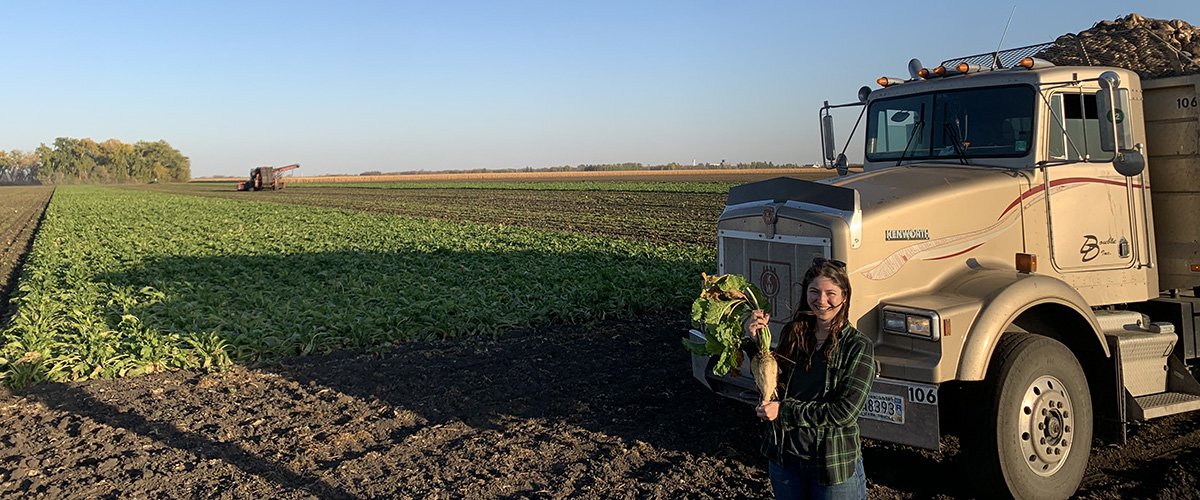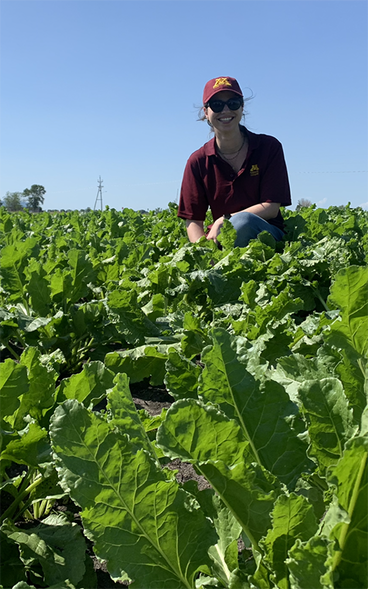
Behind the research: Understanding sugar beet pathogens

On her path to earn a PhD in plant pathology, Sam Rude is studying sugar beet pathogens at the Northwest Research & Outreach Center in Crookston. Sam is co-advised by Plant Pathology Assistant Professors Ashok Chanda and Cory Hirsch. We chatted with Sam to learn more about her research and how it impacts sugar beet production in Minnesota.
How would you explain plant pathology research to someone unfamiliar with it?
Like people, plants can get sick from a bunch of different organisms like viruses and bacteria. Organisms that cause disease in their host are called pathogens. Plant pathologists work to study a bit more about the interaction between plants and pathogens to help develop ways to protect plants and help them fight against pathogens and remain strong. Plants cannot defer an attack by running away or picking up a weapon, so learning how to strengthen a plant’s defenses can help them resist damage from pathogens. This may involve basic protection (specifically effective fungicides) and/or breeding that focuses on building resistance inside the plant itself.

You're studying sugar beet pathogens. What does your research focus on?
My work focuses on a particular pathogen of sugar beets called Aphanomyces cochlioides which causes a disease known as Aphanomyces root rot (ARR). Minnesota is one of the nation’s top producers of sugar beets – which are used to create the white sugar that you might use at home. My research on ARR is split into three sections:
- genetic analysis of the pathogen
- scientific investigation of the sugar beets’ natural protection
- study of the way that sugar beet and ARR interact
Learning more about these areas will help us develop methods to protect sugar beets against the different levels of diseases caused by ARR and ideally, reduce their impact on sugar beet production.
What does a typical day look like in the lab?
Every day in the lab is different depending on where I am in experiments. Often, I have plants and pathogens growing and spend some time checking up on them. I am usually either planning an experiment or analyzing data from a recently completed experiment. Much of the time I have a goal for each experiment, and it is up to me to decide what to do each day to get there.
What are the most significant findings in your research so far that will contribute to the future of sugar beet farming in Minnesota?
We’ve discovered that there is much more genetic diversity in this pathogen than we had originally expected. This means that control methods that work for one grower may not work for another. Plants may be resistant to one version of the pathogen but susceptible to another. There is no “one size fits all solution” – yet.
Ideally, the data and findings that we are uncovering will be able to help us create control strategies that can be deployed to different plant types and varieties. We're learning more specifically about Aphanomyces from different areas of Minnesota and North Dakota vary in terms of how they cause disease and/or how severe the disease they cause is. This will help us make control strategies, such as resilient sugar beets, that can be more tailored to local conditions. Hopefully, we will also know more about how beets protect themselves from disease so that we can integrate that resistance into beets that already have good traits (like high sugar content) to set growers up for success.
How do you intend to use your degree and this research experience as you graduate?
I'm still working out what exactly I want to do in the future. At the very least, I will use my degree to increase our understanding of plant pathogens. It's important to me to focus on problems that growers face so that I can use my research experience to support the very people that make my work possible. Joining the world of sugar beets has taught me a lot about different cropping systems, especially those in the Red River Valley, and I've appreciated this experience immensely.





